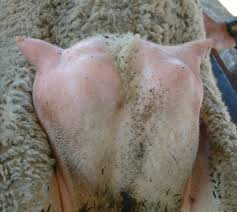Mastitis is a bacterial infection of the udder. A number of severe cases have been reported this year. It is very seasonal and the wet summer/autumn plus good lactation has most likely contributed to the above average prevalence this year.
Mastitis is most common in ewes raising multiple lambs or with high milk production. Most cases occur during the first weeks after lambing or immediately before weaning. Good ewe nutrition and providing a clean lambing environment are important factors in reducing the incidence of mastitis.
Mastitis occurs when a bacterial infection enters the udder through injured teats.
Mastitis is most commonly associated with ewes raising multiple lambs or high milk producing breeds, including Poll Dorset and Suffolk. The disease is less common in Merino ewes rearing single lambs.
Two bacterial species are responsible for causing more than 80% of mastitis cases. Both are normal inhabitants of the skin and oral cavities of both the
lamb and the ewe. Heavily stocked paddocks or yarding for extended periods increases the prevalence of the two bacterial species. The bacteria are resistant to a number of commonly used antibiotics so it is recommended that producers seek veterinary advice before treating affected animals.
resistant to a number of commonly used antibiotics so it is recommended that producers seek veterinary advice before treating affected animals.
Ewes are more susceptible to mastitis if they have some physical injury to their teats, such as:
Ewes in wet, dirty or crowded conditions are more likely to be exposed to sufficient concentrations of bacteria to initiate mastitis.
Increased incidence of mastitis may also be seen in unusual seasonal conditions as well. In the Strathalbyn area this year a producer lost 30 ewes and 25 lambs in May due to an unusual outbreak of scabby mouth in one mob. The virus affected the udders of the ewes and resulted in many cases of mastitis.
There are two forms of mastitis: clinical and subclinical.
Subclinical mastitis may be difficult to identify. The udder may be firm and hot and lambs of affected ewes may have poor growth rates with occasional deaths in twin lambs.
In clinical mastitis, the infection rapidly progresses over several days to blackening of the udder, which feels cold to the touch due to the death of udder tissue (often called 'black mastitis'). The ewe may appear lame or continually lie down and the lambs become hollow and depressed. Lambs may die from lack of milk or from a bacterial infection from consuming infected milk. Poor weather or inadequate nutrition may trigger the progression from subclinical to clinical mastitis.
Producers should consider humane euthanasia of ewes with black mastitis that do not show an immediate response to veterinary treatment, and culling of recovered ewes after weaning as they may have permanent damage to one or more teats.
A veterinarian can help by correctly diagnosing the condition and determining the infectious agent. Seek veterinary advice on specific treatments for mastitis in sheep as antibiotic therapy will often be required. Antibiotic choice needs to be made on the basis of laboratory testing as many bacteria that cause mastitis are resistant to common antibiotics.
Prevention: Good ewe nutrition and providing a clean lambing paddock are important factors in reducing the incidence of mastitis.
Maintain good hygiene if sheep are housed, and avoid prolonged periods in muddy yards and laneways during the first six weeks of lactation.
Ensure ewes have good health / immunity (i.e. adequate condition & selenium / vitamin E pre-lambing and good internal parasite management). An injection with vitamin AD&E along with 5in1 four weeks pre-lambing could be beneficial.
Depending on the severity of the mastitis, ewes may have permanent damage to the udder after an infection. Culling these ewes after their lambs have been weaned will help to prevent a recurring problem with mastitis in the flock.
For further information contact your local veterinarian or Livestock Consultant.
Source: DAFWA